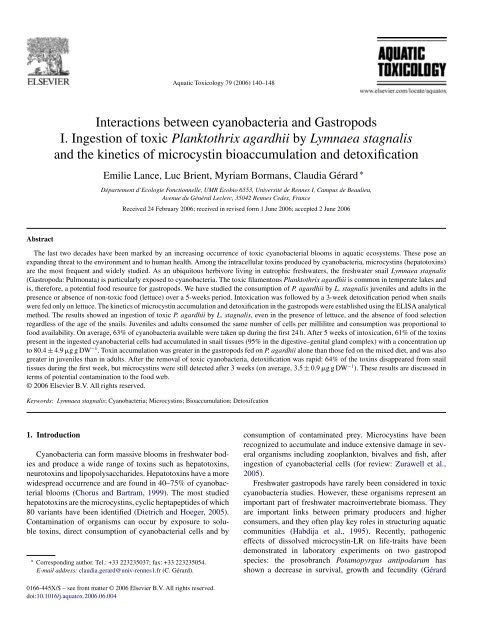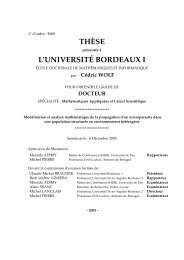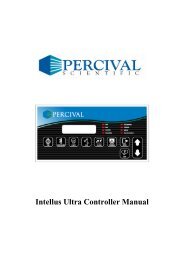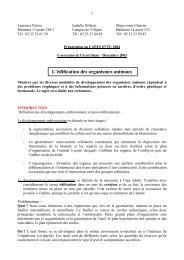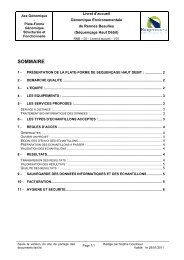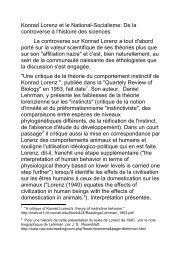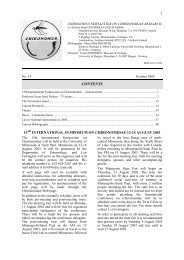Interactions between cyanobacteria and Gastropods I ... - Ecobio
Interactions between cyanobacteria and Gastropods I ... - Ecobio
Interactions between cyanobacteria and Gastropods I ... - Ecobio
Create successful ePaper yourself
Turn your PDF publications into a flip-book with our unique Google optimized e-Paper software.
Abstract<br />
Aquatic Toxicology 79 (2006) 140–148<br />
<strong>Interactions</strong> <strong>between</strong> <strong>cyanobacteria</strong> <strong>and</strong> <strong>Gastropods</strong><br />
I. Ingestion of toxic Planktothrix agardhii by Lymnaea stagnalis<br />
<strong>and</strong> the kinetics of microcystin bioaccumulation <strong>and</strong> detoxification<br />
Emilie Lance, Luc Brient, Myriam Bormans, Claudia Gérard ∗<br />
Département d’Ecologie Fonctionnelle, UMR <strong>Ecobio</strong> 6553, Université de Rennes I, Campus de Beaulieu,<br />
Avenue du Général Leclerc, 35042 Rennes Cedex, France<br />
Received 24 February 2006; received in revised form 1 June 2006; accepted 2 June 2006<br />
The last two decades have been marked by an increasing occurrence of toxic <strong>cyanobacteria</strong>l blooms in aquatic ecosystems. These pose an<br />
exp<strong>and</strong>ing threat to the environment <strong>and</strong> to human health. Among the intracellular toxins produced by <strong>cyanobacteria</strong>, microcystins (hepatotoxins)<br />
are the most frequent <strong>and</strong> widely studied. As an ubiquitous herbivore living in eutrophic freshwaters, the freshwater snail Lymnaea stagnalis<br />
(Gastropoda: Pulmonata) is particularly exposed to <strong>cyanobacteria</strong>. The toxic filamentous Planktothrix agardhii is common in temperate lakes <strong>and</strong><br />
is, therefore, a potential food resource for gastropods. We have studied the consumption of P. agardhii by L. stagnalis juveniles <strong>and</strong> adults in the<br />
presence or absence of non-toxic food (lettuce) over a 5-weeks period. Intoxication was followed by a 3-week detoxification period when snails<br />
were fed only on lettuce. The kinetics of microcystin accumulation <strong>and</strong> detoxification in the gastropods were established using the ELISA analytical<br />
method. The results showed an ingestion of toxic P. agardhii by L. stagnalis, even in the presence of lettuce, <strong>and</strong> the absence of food selection<br />
regardless of the age of the snails. Juveniles <strong>and</strong> adults consumed the same number of cells per millilitre <strong>and</strong> consumption was proportional to<br />
food availability. On average, 63% of <strong>cyanobacteria</strong> available were taken up during the first 24 h. After 5 weeks of intoxication, 61% of the toxins<br />
present in the ingested <strong>cyanobacteria</strong>l cells had accumulated in snail tissues (95% in the digestive–genital gl<strong>and</strong> complex) with a concentration up<br />
to 80.4 ± 4.9 ggDW −1 . Toxin accumulation was greater in the gastropods fed on P. agardhii alone than those fed on the mixed diet, <strong>and</strong> was also<br />
greater in juveniles than in adults. After the removal of toxic <strong>cyanobacteria</strong>, detoxification was rapid: 64% of the toxins disappeared from snail<br />
tissues during the first week, but microcystins were still detected after 3 weeks (on average, 3.5 ± 0.9 ggDW −1 ). These results are discussed in<br />
terms of potential contamination to the food web.<br />
© 2006 Elsevier B.V. All rights reserved.<br />
Keywords: Lymnaea stagnalis; Cyanobacteria; Microcystins; Bioaccumulation; Detoxifcation<br />
1. Introduction<br />
Cyanobacteria can form massive blooms in freshwater bodies<br />
<strong>and</strong> produce a wide range of toxins such as hepatotoxins,<br />
neurotoxins <strong>and</strong> lipopolysaccharides. Hepatotoxins have a more<br />
widespread occurrence <strong>and</strong> are found in 40–75% of <strong>cyanobacteria</strong>l<br />
blooms (Chorus <strong>and</strong> Bartram, 1999). The most studied<br />
hepatotoxins are the microcystins, cyclic heptapeptides of which<br />
80 variants have been identified (Dietrich <strong>and</strong> Hoeger, 2005).<br />
Contamination of organisms can occur by exposure to soluble<br />
toxins, direct consumption of <strong>cyanobacteria</strong>l cells <strong>and</strong> by<br />
∗ Corresponding author. Tel.: +33 223235037; fax: +33 223235054.<br />
E-mail address: claudia.gerard@univ-rennes1.fr (C. Gérard).<br />
0166-445X/$ – see front matter © 2006 Elsevier B.V. All rights reserved.<br />
doi:10.1016/j.aquatox.2006.06.004<br />
consumption of contaminated prey. Microcystins have been<br />
recognized to accumulate <strong>and</strong> induce extensive damage in several<br />
organisms including zooplankton, bivalves <strong>and</strong> fish, after<br />
ingestion of <strong>cyanobacteria</strong>l cells (for review: Zurawell et al.,<br />
2005).<br />
Freshwater gastropods have rarely been considered in toxic<br />
<strong>cyanobacteria</strong> studies. However, these organisms represent an<br />
important part of freshwater macroinvertebrate biomass. They<br />
are important links <strong>between</strong> primary producers <strong>and</strong> higher<br />
consumers, <strong>and</strong> they often play key roles in structuring aquatic<br />
communities (Habdija et al., 1995). Recently, pathogenic<br />
effects of dissolved microcystin-LR on life-traits have been<br />
demonstrated in laboratory experiments on two gastropod<br />
species: the prosobranch Potamopyrgus antipodarum has<br />
shown a decrease in survival, growth <strong>and</strong> fecundity (Gérard
<strong>and</strong> Poullain, 2005) while the pulmonate Lymnaea stagnalis<br />
has shown a decrease in fecundity (Gérard et al., 2005).<br />
Freshwater pulmonates like lymnaeids inhabit shallow<br />
littoral zones <strong>and</strong> are predominantly herbivores. They are<br />
considered as indiscriminate grazers searching for food in the<br />
entire water column <strong>and</strong> on various substrates of the littoral<br />
<strong>and</strong> adapt their diet to the relative abundance of available<br />
resources (Bovbjerg, 1968; Reavell, 1980; Brendelberger,<br />
1997). As <strong>cyanobacteria</strong> can dominate phytoplankton community<br />
<strong>and</strong> colonize littoral waters in bloom periods, it is<br />
therefore relevant to ask whether these grazers would consume<br />
large quantities of toxic <strong>cyanobacteria</strong> <strong>and</strong> whether they<br />
would be affected by this consumption. The few field studies<br />
which have included gastropods (Kotak et al., 1996; Zurawell<br />
et al., 1999; Ozawa et al., 2003; Chen et al., 2005) have<br />
hypothesized a consumption of toxic <strong>cyanobacteria</strong> following<br />
a positive relationship found <strong>between</strong> toxin concentration in<br />
phytoplankton <strong>and</strong> microcystin accumulation in gastropod<br />
tissues.<br />
L. stagnalis is characteristic of eutrophic aquatic systems<br />
(Clarke, 1979) which are more prone to <strong>cyanobacteria</strong>l blooms.<br />
Planktothrix agardhii, a filamentous planktonic species is the<br />
most common cyanobacterium in eutrophic lakes of temperate<br />
areas (Scheffer et al., 1997; Brient et al., 2004) <strong>and</strong><br />
has a greater cellular toxin production than other colonial<br />
or unicellular species (Christiansen et al., 2003). Although<br />
this species is planktonic, wind events have been shown to<br />
concentrate filaments in littoral zones. Indeed, Webster <strong>and</strong><br />
Hutchinson (1994) predict that a blue-green population should<br />
be more strongly concentrated towards the downwind end<br />
of a lake. This prediction is in accord with measured distributions<br />
in lakes. Densities of toxic <strong>cyanobacteria</strong> can thus<br />
become very high in shallow waters <strong>and</strong> with the filaments<br />
trapped <strong>and</strong> accumulating in dense macrophytes, on rocks <strong>and</strong><br />
littoral sediments, increasing the probability of grazing by<br />
snails.<br />
This study is the first part of a research program on freshwater<br />
<strong>cyanobacteria</strong>–gastropod interactions <strong>and</strong> examines the<br />
potential of L. stagnalis to ingest P. agardhii <strong>and</strong> to accumulate<br />
microcystins. The second part of our work focuses on the negative<br />
impact of toxic <strong>cyanobacteria</strong> ingestion on the life traits<br />
of gastropods (survival, growth, fecundity), <strong>and</strong> the plasticity of<br />
the response according to their development stage (juveniles or<br />
adults). Results will be presented in a separate publication.<br />
Consumption of <strong>cyanobacteria</strong>l cells by gastropods in the<br />
presence or not of non-toxic food was monitored during 5<br />
weeks to study the feeding behaviour of L. stagnalis. Toxin<br />
production by P. agardhii was evaluated to assess the quantity<br />
of microcystins ingested by snails. Additionally, we investigated<br />
the potential of L. stagnalis to accumulate microcystins<br />
by establishing the kinetics of accumulation <strong>and</strong> detoxification<br />
of microcystins in gastropod tissues during a 5-weeks<br />
intoxification period followed by a 3-weeks detoxification<br />
period, <strong>and</strong> by calculating the ratio of accumulated/ingested<br />
toxins.<br />
We focused the discussion on the potential accumulation of<br />
cyanotoxins by lymnaeid snails in the field <strong>and</strong> contamination<br />
E. Lance et al. / Aquatic Toxicology 79 (2006) 140–148 141<br />
risk for the food web, since these gastropods are consumed daily<br />
by numerous invertebrates (crayfish, leeches, aquatic insects<br />
as adult coleopterans or larval tabanids) <strong>and</strong> vertebrates (fish,<br />
waterfowl) (for review: Michelson, 1957), which in turn are consumed<br />
by aquatic or terrestrial predators like fish, amphibians,<br />
musk rats <strong>and</strong> birds.<br />
2. Material <strong>and</strong> methods<br />
2.1. Biological material<br />
Prior to the experiments, juvenile <strong>and</strong> adult L. stagnalis<br />
(14 ± 1 <strong>and</strong> 25 ± 1 mm shell length, respectively) were acclimatized<br />
at constant temperature (20 ± 1 ◦ C) <strong>and</strong> photoperiod<br />
(12-h light:12-h dark cycle) <strong>and</strong> fed on dried lettuce ad libitum<br />
during 7 days. The filamentous cyanobacterium P. agardhii,<br />
originating from the recreational watersport site at Viry<br />
(Essone, France), was maintained in a modified medium (20 mL<br />
of liquid BG11 per litre of dechlorinated water). Cyanobacteria<br />
were placed in an incubation room at constant temperature<br />
(25 ± 2 ◦ C) <strong>and</strong> photoperiod (12-h light:12-h dark cycle) at<br />
an irradiance of 40 Em −2 s −1 . The algal concentrations of<br />
200,000 cells mL −1 were provided twice a week to the gastropods.<br />
These algal suspensions produced dmMC-LR <strong>and</strong><br />
MC-RR (detected by HPLC–MS), with a total concentration<br />
of 5 gL −1 expressed as microcystins-LR equivalents (MC-<br />
LReq) <strong>and</strong> measured by high-performance liquid chromatography<br />
(HPLC, Section 2.3.2). The density of <strong>cyanobacteria</strong> used<br />
in this study is similar to that commonly found, <strong>and</strong> often<br />
exceeded in natural systems worldwide (Chorus <strong>and</strong> Bartram,<br />
1999).<br />
2.2. Experimental setup<br />
Following the period of acclimatization, snails were divided<br />
into four groups according to age <strong>and</strong> diet for a 5-weeks intoxication<br />
experiment: (1) <strong>cyanobacteria</strong>l suspension as the only food<br />
source for juveniles (juv cyano) <strong>and</strong> (2) for adults (ad cyano),<br />
(3) a mixture of <strong>cyanobacteria</strong>l suspension <strong>and</strong> lettuce ad libitum<br />
for juveniles (juv cyano + let) <strong>and</strong> (4) for adults (ad cyano + let).<br />
Each group consisted of 35 replicates, i.e. 35 isolated individuals,<br />
in glass containers of 15 mL for each juvenile <strong>and</strong> 40 mL<br />
for each adult. Preliminary observations showed that gastropods<br />
consumed the P. agardhii suspension of 200,000 cell mL −1 in<br />
3 days, hence <strong>cyanobacteria</strong> suspension was renewed twice a<br />
week. Control glass containers of 15 <strong>and</strong> 40 mL were filled in the<br />
absence of gastropods, with <strong>cyanobacteria</strong> suspension with <strong>and</strong><br />
without lettuce during 5-weeks. Preliminary experiments performed<br />
over 20 days on 30 replicates with <strong>and</strong> without lettuce<br />
showed that the P. agardhii growth was similar <strong>and</strong> constant.<br />
It was assumed that two replicates per treatment were sufficient<br />
to measure <strong>cyanobacteria</strong>l growth, <strong>and</strong> the influence of the<br />
presence of lettuce on the development of <strong>cyanobacteria</strong>, as the<br />
conditions for growth (light, temperature, nutrient) were identical.<br />
After the intoxication period, all gastropods were fed solely<br />
on lettuce ad libitum <strong>and</strong> maintained in dechlorinated non-toxic<br />
water during a 3-weeks detoxification period.
142 E. Lance et al. / Aquatic Toxicology 79 (2006) 140–148<br />
2.3. Cyanobacterial cells <strong>and</strong> microcystin ingestion<br />
estimates<br />
2.3.1. Growth <strong>and</strong> ingestion model<br />
To estimate the number of cells ingested by L. stagnalis,<br />
<strong>cyanobacteria</strong>l densities were determined daily on microscope<br />
with a Nageotte chamber. The total length of all P. agardhii<br />
filaments in a 50 L volume was measured <strong>and</strong> expressed in<br />
cells mL −1 assuming an average length of one cell of P. agardhii<br />
was 3.12 m, based on 50 measurements. These cell counts<br />
were made in all groups <strong>and</strong> controls for the 5-weeks intoxication<br />
period (10 renewals of suspension). Cyanobacterial growth<br />
rate (µ) was determined from the rate of change in the <strong>cyanobacteria</strong>l<br />
biomass (B) over time in the controls, as follows:<br />
dB<br />
= µB (1)<br />
dt<br />
The time interval used in this study was one day <strong>and</strong> we used<br />
the discrete time form of its precedent transition equation to<br />
estimate the daily growth rate (µ) as follows:<br />
Bt+1 = Bt(1 + µ) (2)<br />
where Bt <strong>and</strong> Bt+1 are, respectively, the biomass of <strong>cyanobacteria</strong><br />
at time t <strong>and</strong> t + 1 (in cells mL −1 ). An assumption was made that<br />
µ was not influenced by the presence or absence of a gastropod.<br />
Hence, the daily gastropod ingestion rate of <strong>cyanobacteria</strong> in<br />
the treatments without lettuce was obtained by including the<br />
ingestion as a loss term (S)inEq.(2) as follows:<br />
B(S)t+1 = B(S)t × (1 + µ − S) (3)<br />
where B(S)t <strong>and</strong> B(S)t+1 are, respectively, the biomass of<br />
<strong>cyanobacteria</strong> at time t <strong>and</strong> t + 1 (in cells mL −1 ) in the treatments<br />
with snails <strong>and</strong> without lettuce. The total number of cells<br />
per millilitre ingested by snail per day was obtained by multiplying<br />
the <strong>cyanobacteria</strong>l biomass B(S)t by the ingestion rate<br />
(S).<br />
As preliminary tests revealed that the addition of lettuce introduced<br />
<strong>and</strong> enhanced the development of microorganisms that<br />
led to a <strong>cyanobacteria</strong>l loss, we also estimated the quantity of<br />
cells ingested by each snail in the presence of lettuce in their<br />
diet. Several assumptions were required to quantify this: (1) that<br />
<strong>cyanobacteria</strong> have the same growth rate (µ) in the presence of<br />
lettuce or not, (2) the snails do not consume microorganisms<br />
<strong>and</strong> (3) the daily loss rate of <strong>cyanobacteria</strong> due to the presence<br />
of lettuce (L) is independent of the presence of a snail. We first<br />
estimated L as follows:<br />
B(L)t+1 = B(L)t × (1 + µ − L) (4)<br />
where B(L)t+1 <strong>and</strong> B(L)t are, respectively, the biomass of<br />
<strong>cyanobacteria</strong> at time t <strong>and</strong> t + 1 (in cell mL −1 ) in the controls<br />
with lettuce <strong>and</strong> no snails. The daily snail ingestion rate<br />
of <strong>cyanobacteria</strong> in the presence of lettuce (SL) was obtained by<br />
considering the presence of microorganisms, as follows:<br />
B(SL)t+1 = B(SL)t × (1 + µ − L − SL) (5)<br />
where B(SL)t+1 <strong>and</strong> B(SL)t are, respectively, the density of<br />
<strong>cyanobacteria</strong> at time t <strong>and</strong> t + 1 (in cell mL −1 ) in the treatments<br />
with lettuce <strong>and</strong> snails. The total number of cells per millilitre<br />
ingested daily by a snail in presence of lettuce was estimated by<br />
multiplying B(SL)t by SL.<br />
The percentage of cells ingested by snails compared to those<br />
available (%conso) in the absence of lettuce was calculated as<br />
follows:<br />
<br />
S<br />
%conso = 100 ×<br />
(6)<br />
1 + µ<br />
The %conso in the presence of lettuce was calculated with SL<br />
instead of S in Eq. (6). Ingestion of <strong>cyanobacteria</strong> by snails was<br />
estimated for each group <strong>and</strong> expressed in several ways: as the<br />
average total number of cells ingested per snail <strong>and</strong> per renewal<br />
of suspension (twice a week), as the average number of cells<br />
ingested per snail <strong>and</strong> per millilitre of available suspension twice<br />
a week, <strong>and</strong> as the average total number of cells ingested per dry<br />
weight of snail <strong>and</strong> per renewal of suspension, in %conso per<br />
day or in average %conso per 3 days.<br />
2.3.2. Ingestion of microcystins: HPLC analysis<br />
Total microcystin content ingested per snail per week was<br />
estimated from the <strong>cyanobacteria</strong>l cell toxin concentration <strong>and</strong><br />
the average number of <strong>cyanobacteria</strong>l cells ingested. Toxin concentration<br />
in <strong>cyanobacteria</strong>l cells was determined each week<br />
with a HPLC with diode array detection (HPLC-DAD) <strong>and</strong> a<br />
variable-wavelength UV detector operating at 238 nm. Prior to<br />
HPLC analysis, cells harvested by filtration (nylon cloth, 2 m<br />
pore size) were suspended in 0.5 mL of 85% methanol in water<br />
<strong>and</strong> centrifuged at 7000 × g for 7 min. The volume injected was<br />
20 L with a flow rate of 1 mL min −1 . The separation was performed<br />
on a microspher C18 reverse-phase column (3 m) under<br />
isocratic conditions with a mobile phase of 10 mm ammonium<br />
acetate <strong>and</strong> acetonitrile (7.4:2.6) for 10 min. As microcystin-LR<br />
was the st<strong>and</strong>ard used, concentration was expressed as microgram<br />
cellular MC-LReq per litre of suspension. Microcystin<br />
contents estimated were combined with cell counts to derive<br />
a relation <strong>between</strong> algal density <strong>and</strong> microcystin production to<br />
obtain the amount of toxins produced by one cell of P. agardhii.<br />
2.4. Quantitative analysis of MC-LReq in exposed snail<br />
tissues <strong>and</strong> quality control of microcystin measurement<br />
Every week, two snails were r<strong>and</strong>omly chosen from each<br />
group <strong>and</strong> were starved for ca. 24 h to empty their gut contents<br />
(Carriker, 1946) to ensure that the microcystin measurement<br />
reflected only assimilated toxins <strong>and</strong> did not include microcystins<br />
in the undigested filaments of P. agardhii or microcystins<br />
in the gut. Snails were removed from their shells, freeze-dried<br />
<strong>and</strong> weighed prior to microcystin analysis. This analysis was<br />
performed by immuno-assay with an ELISA Microcystin Plate<br />
Kit (Envirologix Inc.), which detects all of the 6 purified hepatotoxins<br />
of common bloom-forming <strong>cyanobacteria</strong>, especially<br />
MC-LR <strong>and</strong> MC-RR, from 0.05 gL −1 threshold <strong>and</strong> to the<br />
nearest 0.01 gL −1 (Codd et al., 1997; Gilroy et al., 2000). All<br />
microcystins of the P. agardhii strain used were thus detected
<strong>and</strong> expressed in MC-LReq using MC-LR, given by the supplier<br />
as st<strong>and</strong>ard. Microcystins were extracted with 2 mL of 100%<br />
methanol (Codd et al., 1997). Each snail was crushed in 1 mL of<br />
100% MeOH <strong>and</strong> then crushed again after 12 h at 4 ◦ C with 1 mL<br />
MeOH added. For the immuno-assay analysis the extract was<br />
diluted with water to less than 5% MeOH (Beattie et al., 1998).<br />
At the end of both the intoxication <strong>and</strong> detoxification periods,<br />
microcystin analysis was performed separately on the cephalopedial<br />
zone <strong>and</strong> the digestive–genital gl<strong>and</strong> complex. The aim<br />
was to determine the relative importance of visceral mass <strong>and</strong><br />
foot muscle tissue in the accumulation. Microcystin contents<br />
in snail tissues are expressed in ggFW −1 (fresh weight) <strong>and</strong><br />
in ggDW −1 (dry weight) according to the relation previously<br />
established: FW = 7.47 × DW (n = 30, R Pearson = 0.94,<br />
P < 0.05). The values were calculated by taking into account<br />
extraction recovery <strong>and</strong> possible matrix-induced signal enhancement<br />
or suppression with the ELISA test because of unspecific<br />
binding to <strong>and</strong>/or denaturing of the antibodies. Control snails,<br />
free of microcystins, were freeze-dried <strong>and</strong> homogenized in a<br />
mortar, spiked with MC-LR st<strong>and</strong>ard (5 gg −1 )(Dionisio Pires<br />
et al., 2004). The extraction was performed as described previously<br />
<strong>and</strong> the recovery for the extraction was calculated. The<br />
matrix effect (i.e. effect of snail tissue) was checked by spiking<br />
control snails with MC-LR st<strong>and</strong>ard (5 gg −1 ) <strong>and</strong> the<br />
response was compared to 100% methanol spiked with the same<br />
amount (Dionisio Pires et al., 2004). The average recovery was<br />
72 ± 5.3% <strong>and</strong> matrix effect was negligible (from 0.05 to 4.8%<br />
of differences <strong>between</strong> matrix <strong>and</strong> methanol results with an average<br />
of 1.7 ± 0.4%). Similar results about the matrix effect with<br />
the ELISA test were observed by Ernst et al. (2005).<br />
The percentage bioaccumulation (%acc) was calculated each<br />
week based on the ratio <strong>between</strong> the average quantity of MC-<br />
LReq accumulated in snail tissues <strong>between</strong> weeks 1 <strong>and</strong> n (in<br />
g) <strong>and</strong> the estimated average quantity of MC-LReq ingested<br />
<strong>between</strong> weeks 1 <strong>and</strong> n (in g). During the detoxification period,<br />
the percentage toxin elimination from snail tissues (%detox) was<br />
calculated <strong>between</strong> weeks by the expression:<br />
% detox = 100 × [MC-LReq n − MC-LReq n+1 ]<br />
MC-LReq n<br />
2.5. Statistical analysis<br />
Pearson’s coefficient (R Pearson) was calculated to assess<br />
the existence of a correlation <strong>between</strong>: (1) the quantity of<br />
microcystins produced <strong>and</strong> the density of <strong>cyanobacteria</strong>l suspensions<br />
(n = 90), (2) the fresh <strong>and</strong> dry weights of snails<br />
(n = 30). One analysis of covariance (ANCOVA) was performed<br />
on the <strong>cyanobacteria</strong> counts in the controls to compare<br />
their growth rates (µ) <strong>between</strong> weeks <strong>and</strong> volumes of culture<br />
medium (n = 120). Two-way analyses of variance (ANOVA)<br />
with repeated measures <strong>and</strong> the Tukey HSD multiple comparison<br />
test were performed to compare: (1) the total number of<br />
<strong>cyanobacteria</strong>l cells <strong>and</strong> the number of <strong>cyanobacteria</strong>l cells per<br />
millilitre ingested per snail, (2) the average %conso of snails<br />
over a 3 days period, (3) the total number of <strong>cyanobacteria</strong>l<br />
cells ingested per dry weight of snails, (4) the quantity of micro-<br />
E. Lance et al. / Aquatic Toxicology 79 (2006) 140–148 143<br />
(7)<br />
cystins bioaccumulated in ggDW −1 , (5) the %acc, (6) the<br />
%detox. Differences were considered to be statistically significant<br />
at P < 0.05. Data are reported as means ± st<strong>and</strong>ard errors<br />
(±S.E.).<br />
3. Results<br />
3.1. Ingestion of P. agardhii cells <strong>and</strong> microcystins<br />
The daily growth rate µ of P. agardhii was similar in the<br />
15 or 40 mL containers <strong>and</strong> <strong>between</strong> weeks in the controls<br />
(<strong>cyanobacteria</strong> alone) (ANCOVA, n = 120, P = 0.53), <strong>and</strong> was<br />
0.19 ± 0.02 day −1 (Fig. 1). When lettuce was present, cell density<br />
of P. agardhii was lower (Fig. 1), showing a loss of <strong>cyanobacteria</strong><br />
to the introduced microorganisms which almost compensated<br />
for the growth rate. When snails were present, with or<br />
without lettuce, <strong>cyanobacteria</strong> density was lower than in their<br />
absence (Fig. 1), demonstrating the consumption of P. agardhii<br />
by L. stagnalis. In the 40 mL algal suspension, adults consumed<br />
2.5 times more cells than juveniles in a 15 mL algal suspension<br />
over the 3 days, with <strong>and</strong> without lettuce (ANOVA F3,20 = 434.3,<br />
P < 0.05 <strong>and</strong> Tukey HSD, P < 0.05) (Table 1). When expressed<br />
in cell number per millilitre, consumption was similar in adults<br />
Fig. 1. Dynamics of P. agardhii populations during 3 days: alone (open diamond)<br />
<strong>and</strong> with lettuce (closed diamond), in the presence of snails as juveniles (triangle)<br />
<strong>and</strong> adults (circle) without (open) <strong>and</strong> with lettuce (closed) (dotted line for 15 mL<br />
<strong>and</strong> continuous line for 40 mL glass containers).<br />
Table 1<br />
Mean (±S.E.) ingestion of P. agardhii cells by L. stagnalis juveniles <strong>and</strong> adults<br />
over 3 days during the 5-weeks intoxication period in the presence or absence<br />
of lettuce (cells per snail, cells per snail per mL)<br />
Juveniles fed on<br />
<strong>cyanobacteria</strong> (juv cyano)<br />
Juveniles fed on<br />
<strong>cyanobacteria</strong> <strong>and</strong> lettuce<br />
(juv cyano + let)<br />
Adults fed on <strong>cyanobacteria</strong><br />
(ad cyano)<br />
Adults fed on <strong>cyanobacteria</strong><br />
<strong>and</strong> lettuce (ad cyano + let)<br />
Cells per snail Cells per snail per mL<br />
3376000 ± 18000 225000 ± 1200<br />
2882000 ± 124000 192000 ± 8000<br />
8428000 ± 160000 211000 ± 4000<br />
7214000 ± 358000 180000 ± 9000
144 E. Lance et al. / Aquatic Toxicology 79 (2006) 140–148<br />
<strong>and</strong> juveniles (Tukey HSD, P > 0.05) but different according<br />
to the diet (ANOVA F3,20 = 23.5, P < 0.05). Snails with lettuce<br />
consumed less cells per millilitre than snails without lettuce,<br />
regardless of age (Tukey HSD, P < 0.05) (Table 1). This difference<br />
reflects the diminution of the availability of <strong>cyanobacteria</strong><br />
due to the presence of lettuce. The mean %conso over 3 days,<br />
which takes account of the decline in available <strong>cyanobacteria</strong>l<br />
cells for snails when microorganisms were present, was<br />
not significantly different <strong>between</strong> groups <strong>and</strong> weeks (ANOVA,<br />
respectively, F3,20 = 2.3 <strong>and</strong> F4,20 = 1.3, all P > 0.05). In each age<br />
class, it was similar in the presence or absence of lettuce (Tukey<br />
HSD, all P > 0.05), suggesting an absence of non-toxic food<br />
selection in juveniles <strong>and</strong> adults. In addition, the daily %conso<br />
changed over the 3 days during the intoxication period (ANOVA,<br />
F2,108 = 91.4, P < 0.05). It was significantly higher the first day<br />
(Tukey HSD, P < 0.05), 62.8 ± 1.7% for all groups, whereas it<br />
did not significantly differ during the remaining 2 days (Tukey<br />
HSD, P > 0.05), mean of 33.1 ± 1.8%.<br />
When normalised against dry weight of snails, total number<br />
of cells ingested differed according to age (ANOVA,<br />
F3,20 = 97.6, P < 0.05). Adults ingested in total 1.4 times more<br />
cells per gram of dry weight than juveniles (Tukey HSD,<br />
P < 0.05). Such differences are relevant for comparisons of the<br />
differences in bioaccumulation of toxins per gram of weight.<br />
The total quantity of microcystins ingested was estimated<br />
from the production of MC-LReq by one P. agardhii cell<br />
(3 × 10 −8 g, n = 45, R Pearson = 0.9, P < 0.05). It was about<br />
2.5 times higher for adults than for juveniles, in relation with<br />
the total number of cells ingested. At the end of the 5 weeks<br />
intoxication period, the total content of microcystins consumed<br />
was estimated for adults at 2.2 ± 0.0 g ind −1 without lettuce<br />
<strong>and</strong> 1.9 ± 0.1 g ind −1 with lettuce, <strong>and</strong> for juveniles at<br />
0.9 ± 0.0 g ind −1 without lettuce <strong>and</strong> 0.7 ± 0.0 g ind −1 with<br />
lettuce.<br />
3.2. Bioaccumulation <strong>and</strong> detoxification<br />
Microcystin contents in snails increased steadily during the<br />
intoxication <strong>and</strong> reached a maximum of 80.4 ± 4.9 ggDW −1<br />
(10.8 ± 0.7 ggFW −1 ) after 5 weeks in the case of juveniles<br />
without lettuce (Fig. 2). Differences in MC-LReq contents per<br />
gram were significant <strong>between</strong> groups (ANOVA, F3,20 = 24.8,<br />
P < 0.05). Juveniles accumulated 2 times more toxins per gram<br />
than adults (Tukey HSD, P < 0.05), in spite of having consumed<br />
1.4 times less cells per gram of dry weight (<strong>and</strong> 2.5 times<br />
less cells in total). Moreover, individuals fed on <strong>cyanobacteria</strong><br />
alone accumulated more toxins per weight than those fed on the<br />
mixed diet (Tukey HSD, P < 0.05). The %acc, which takes into<br />
account differences in cell consumptions, varied <strong>between</strong> groups<br />
Fig. 2. Kinetics of MC-LReq in L. stagnalis tissues (ggDW −1 ) of juveniles<br />
(triangle) <strong>and</strong> adults (circle) fed on <strong>cyanobacteria</strong> without (open) <strong>and</strong> with lettuce<br />
(closed) during 5 weeks of intoxication, then fed on lettuce during 3 weeks of<br />
detoxification.<br />
(ANOVA, F3,20 = 7.1, P < 0.05) <strong>and</strong> showed similar trends. In<br />
general, juveniles accumulated greater proportions of ingested<br />
microcystins than adults, <strong>and</strong> for both ages, snails fed on P.<br />
agardhii alone had a greater %accu than snails fed on mixed<br />
diet (Fig. 3). However, only the differences <strong>between</strong> adults fed<br />
on P. agardhii alone <strong>and</strong> the other groups were significant (Tukey<br />
HSD, P < 0.05). An average of 61% of total ingested toxins was<br />
accumulated by all gastropods after the intoxication.<br />
In addition, more than 95% of accumulated toxins were<br />
located in digestive–genital gl<strong>and</strong> complex (less than 5% in<br />
cephalopedial zone) (Table 2).<br />
During the 3 weeks-detoxification period, mean microcystin<br />
contents declined in all groups from 48.0 ± 7.9<br />
to 3.5 ± 0.9 ggDW −1 (or from 6.4 ± 0.9 to 0.4 ±<br />
0.1 ggFW −1 ). Adult snails fed on P. agardhii alone,<br />
which had accumulated the highest total quantity of toxins<br />
at week 5 (in the whole body <strong>and</strong> not per gram of weight),<br />
eliminated every week a greater proportion of the toxin contents<br />
Fig. 3. Mean (±S.E.) percentage of ingested MC-LReq accumulated in L. stagnalis<br />
tissues (%acc) of juveniles (juv) <strong>and</strong> adults (ad) fed on <strong>cyanobacteria</strong><br />
without (cyano) <strong>and</strong> with lettuce (cyano + let) during 5 weeks of intoxication.<br />
Table 2<br />
Mean (±S.E.) concentration of MC-LReq (ggDW −1 )inL. stagnalis digestive–genital gl<strong>and</strong> complex at the end of 5-weeks intoxication <strong>and</strong> 3-weeks detoxification<br />
periods according to the age <strong>and</strong> the presence of lettuce (see abbreviations in Table 1)<br />
juv cyano juv cyano + let ad cyano ad cyano + let<br />
End of intoxication 194.8 ± 13.5 170.5 ± 12.9 135.8 ± 1.4 35.8 ± 4.0<br />
End of detoxification 22.1 ± 2.1 20.4 ± 4.9 9.4 ± 0.9 4.6 ± 0.5
Table 3<br />
Mean (±S.E.) percentage of MC-LReq eliminated every week in L. stagnalis<br />
tissues (%detox) during the 3-weeks detoxification period, according to the age<br />
<strong>and</strong> the presence of lettuce (see abbreviations in Table 1)<br />
Weeks juv cyano juv cyano + let ad cyano ad cyano + let<br />
6 42.1 ± 2.4 76.9 ± 1.1 81.0 ± 0.9 54.4 ± 3.9<br />
7 55.9 ± 2.3 31.0 ± 2.4 67.8 ± 5.6 63.3 ± 1.9<br />
8 55.2 ± 2.1 63.9 ± 0.9 43.7 ± 5.0 37.9 ± 3.6<br />
in their tissues than other groups (ANOVA, F3,156 = 11.5,<br />
P < 0.05 <strong>and</strong> Tukey HSD, P < 0.05), which showed similar<br />
percentages of detoxification (Tukey HSD, P > 0.05) (Table 3).<br />
Moreover, the percentage detoxification was significantly<br />
higher the first week: 63.6 ± 2.1% for all groups (ANOVA,<br />
F2,156 = 19.7, P < 0.05 <strong>and</strong> Tukey HSD, P < 0.05), whereas<br />
elimination of toxins did not significantly differ during<br />
the last 2 weeks, 54.5 ± 3.0 <strong>and</strong> 50.2 ± 2.9%, respectively<br />
(Tukey HSD, P > 0.05). At the end of the experiments, snails<br />
had eliminated on average 91.9 ± 0.5% of the accumulated<br />
toxins.<br />
4. Discussion<br />
The results show that L. stagnalis ingested hepatotoxic strains<br />
of P. agardhii, even in the presence of another non-toxic food<br />
source (lettuce). Therefore, no food selection by L. stagnalis<br />
occurred in contrast to some copepod <strong>and</strong> fish species which<br />
have been shown to select <strong>and</strong> ingest only the non-toxic food in<br />
laboratory experiments (for review: Zurawell et al., 2005). On<br />
average 63% of <strong>cyanobacteria</strong>l cells were consumed during the<br />
first 24 h <strong>and</strong> 33% during the remaining 2 days. We observed<br />
that <strong>cyanobacteria</strong>l filaments sank quickly to the bottom of containers<br />
after the renewals of suspension, forming a dense layer of<br />
food for snails. Sedimentation was probably due to the absence<br />
a buoyancy control necessary to access light since the light climate<br />
was homogenous in glass containers. Search for food by L.<br />
stagnalis is done by r<strong>and</strong>om movements (Bovbjerg, 1968) <strong>and</strong><br />
the decrease of <strong>cyanobacteria</strong> consumption after 24 h may be a<br />
consequence of the decrease in encounter rates <strong>between</strong> snail<br />
<strong>and</strong> <strong>cyanobacteria</strong>l cells. The search for food is accomplished<br />
by waving the head from side to side, <strong>and</strong> the tentacles are sensitive<br />
to food contact. As <strong>cyanobacteria</strong> were consumed, their<br />
concentrations decreased <strong>and</strong> the probability of detection by the<br />
snail was reduced.<br />
In the presence of lettuce, <strong>cyanobacteria</strong> were consumed by<br />
snails, but P. agardhii availability was also decreased due to<br />
microorganisms. Snails consumed the same proportion of available<br />
cells as when fed only on <strong>cyanobacteria</strong>, but ingested a<br />
smaller total number of cells. As found by Sheerboom <strong>and</strong><br />
Geldof (1978), the amount of food ingested is always related to<br />
the amount available <strong>and</strong> L. stagnalis fed almost continuously<br />
day <strong>and</strong> night without reaching a satiety threshold. Comparison<br />
<strong>between</strong> adults <strong>and</strong> juveniles showed that they consumed the<br />
same number of cells per millilitre. The feeding behaviour of L<br />
stagnalis was similar irrespective of age <strong>and</strong> of alternative non-<br />
E. Lance et al. / Aquatic Toxicology 79 (2006) 140–148 145<br />
toxic food source, the determining factor was the availability of<br />
<strong>cyanobacteria</strong> in the medium.<br />
Following consumption of toxic <strong>cyanobacteria</strong>, lymnaeid<br />
snails rapidly accumulated microcystins readily detectable at<br />
the end of the first week of intoxication period (a maximum<br />
of 619 ng of MC-LReq in total body) <strong>and</strong> increasing with time<br />
(a maximum of 3.2 g in total body after 5 weeks). Juvenile<br />
snails fed on <strong>cyanobacteria</strong> had the greatest microcystin concentration<br />
per gram at week 5: on average 80.4 ± 4.9 ggDW −1<br />
(Fig. 2). A similar bioaccumulation was observed in the gastropod<br />
Sinotaia histrica after consumption of a toxic Microcystis<br />
strain (Ozawa et al., 2003). In Canadian lakes, Zurawell et al.<br />
(1999) reported similar or higher values of microcystin accumulation<br />
in three gastropod species (up to 140 ggDW −1 for L.<br />
stagnalis, 130 ggDW −1 for Physa gyrina <strong>and</strong> 40 ggDW −1<br />
for Helisoma trivolis). They considered that the concentration<br />
of MC-LReq in tissues was correlated with toxins found<br />
in phytoplankton (up to 1526 ggDW −1 in hypereutrophic<br />
lakes), <strong>and</strong> not with dissolved toxins (up to 1.2 gL −1 ). In<br />
laboratory experiments, L. stagnalis exposed for 6 weeks to<br />
33 gL −1 dissolved MC-LR accumulated only a maximum<br />
of 0.06 ggDW −1 (Gérard et al., 2005). For comparison, L.<br />
stagnalis in this study, exposed to 5 gL −1 of intracellular<br />
MC-LReq, accumulated almost 1300 times more toxins after<br />
5 weeks. It appears from these results that gastropods accumulated<br />
microcystins mainly by grazing toxic phytoplankton, <strong>and</strong><br />
to a lesser extent, via uptake of dissolved toxins.<br />
Based on the percentage of accumulation, an average of 61%<br />
of total ingested toxins was accumulated by all gastropods after<br />
the intoxication. However, microcystin concentrations found in<br />
L. stagnalis were probably underestimated in the present experiment,<br />
due to the limitation in microcystin extraction from snail<br />
tissues. Indeed, an undetermined part of microcystins, i.e. those<br />
covalently bound to protein phosphatase, are not extractable by<br />
methanol <strong>and</strong> not detectable by the ELISA test. Thus, the microcystin<br />
concentrations we reported in tissue samples correspond<br />
to free <strong>and</strong> metabolised microcystins (i.e. conjugated with glutathione<br />
<strong>and</strong> cysteine, with which microcystin antibodies of the<br />
ELISA test crossreact by immunoaffinity (Metcalf et al., 2000)).<br />
The existence of non-extractable microcystins has been demonstrated<br />
in some bivalves by several authors (Williams et al., 1997;<br />
Dionisio Pires et al., 2004; Dietrich <strong>and</strong> Hoeger, 2005). Less than<br />
0.1% of the total microcystins was extractable with methanol in<br />
saltwater mussels (Williams et al., 1997). In zebra mussels, covalently<br />
bound MC-LR was generally lower than free unbound<br />
MC-LR but could reach 62% of free MC-LR (Dionisio Pires<br />
et al., 2004). Further investigations are required to estimate the<br />
percentage of covalently bound <strong>and</strong> free microcystins in snail<br />
tissues.<br />
The 39% of total ingested microcystins that were not measured<br />
in L. stagnalis are thought to have been partly: (i) eliminated<br />
in the gizzard <strong>and</strong> cecal string fraction of the faeces<br />
(undigested cells) during the first hours post ingestion. According<br />
to Zurawell et al. (2006), 57% of the initial microcystin<br />
concentration are found in this faeces fraction of L. stagnalis<br />
within 8 h after removal from microcystin-containing <strong>cyanobacteria</strong><br />
exposure. Other possible mechanisms by which ingested
146 E. Lance et al. / Aquatic Toxicology 79 (2006) 140–148<br />
microcystins escaped measurement include: (ii) entering the<br />
digestive gl<strong>and</strong>, where intracellular digestion of <strong>cyanobacteria</strong><br />
occurred, followed by excretion in the digestive gl<strong>and</strong> fraction<br />
of the faeces (Carriker, 1946; Zurawell et al., 2006); (iii) entering<br />
in the digestive gl<strong>and</strong> <strong>and</strong> accumulating through binding<br />
covalently to protein phosphatase enzymes <strong>and</strong> thus being undetectable<br />
(Dietrich <strong>and</strong> Hoeger, 2005).<br />
The major accumulation site of microcystins in both experimentally<br />
exposed <strong>and</strong> wild invertebrates <strong>and</strong> vertebrates is the<br />
digestive gl<strong>and</strong> (or liver) (Vasconcelos, 1995; Cazenave et al.,<br />
2005). According to Chen et al. (2005), the mean distribution of<br />
microcystins in the gastropod Bellamya aeruginosa is as follows:<br />
64.5% in the digestive gl<strong>and</strong> (4.4 ggDW −1 MC-LReq), 24.8%<br />
in the digestive tractus (1.7 ggDW −1 MC-LReq), 10.6% in the<br />
genital gl<strong>and</strong> (0.7 ggDW −1 MC-LReq) <strong>and</strong> 0.2% in the foot<br />
(0.05 ggDW −1 ). In this study, more than 95% of accumulated<br />
MC-LReq is detected in the digestive–genital gl<strong>and</strong> complex of<br />
L. stagnalis, with an average concentration of 135 ggDW −1<br />
at the end of intoxication period.<br />
Bioaccumulation capacity showed two trends according to<br />
age <strong>and</strong> diet: (1) juveniles accumulated a greater proportion of<br />
ingested toxins than adults (66% versus 47%), (2) lymnaeids<br />
which received only <strong>cyanobacteria</strong> had a greater accumulation<br />
than those fed on <strong>cyanobacteria</strong> with lettuce (64% versus<br />
50%). Moreover, despite a larger intake of toxic food per body<br />
weight, adult snails had less amounts of toxins per gram, indicating<br />
they were more efficient in detoxifying <strong>and</strong>/or excreting<br />
the toxins than juveniles. Detoxification processes have<br />
been shown to occur in various organisms (e.g., plants, invertebrates<br />
<strong>and</strong> vertebrates) <strong>and</strong> allow organisms to survive under<br />
<strong>cyanobacteria</strong>l stress (for review, see Cazenave et al., 2006).<br />
Accumulated microcystins can be metabolized into less harmful<br />
compounds after conjugation with glutathione via glutathione-<br />
S-transferase or glutathione peroxidase, resulting in microcystin<br />
excretion or physiological degradation. Previous studies,<br />
reported in Cazenave et al. (2006), have demonstrated that toxic<br />
<strong>cyanobacteria</strong> induce the production of reactive oxygen species<br />
(ROS) in relation with the immunological system. This oxidative<br />
stress is known to be reduced by the activity of antioxidant<br />
enzymes, such as glutathione peroxidase. The higher accumulation<br />
of cyanotoxins in juvenile (versus adult) L. stagnalis may<br />
be due to the less well developed, <strong>and</strong> therefore less competent,<br />
immune system (Dikkeboom et al., 1985), with a consequently<br />
less efficient detoxification system. Moreover, the resource allocated<br />
to detoxification processes, which has a high energy cost,<br />
should be derived from a common pool of limited resources used<br />
by all fitness-associated traits (Rigby <strong>and</strong> Jokela, 2000). Thus,<br />
snails which had received lettuce with <strong>cyanobacteria</strong> had a lower<br />
accumulation probably due to the enhanced energy uptake allowing<br />
a more efficient detoxification. The consequences of toxic<br />
<strong>cyanobacteria</strong> consumption in terms of impact on life traits <strong>and</strong><br />
energy allocation according to the age <strong>and</strong> the food diet in L.<br />
stagnalis will be reported in a separate publication (in preparation).<br />
As a consequence of detoxification processes in organisms<br />
exposed to toxic <strong>cyanobacteria</strong>, the potential contamination of<br />
the food web may be thought to be limited. At present, few tox-<br />
icological studies (Laurén-Määttä et al., 1995; Engström-Öst<br />
et al., 2002; Ibelings et al., 2005) have investigated the transfer<br />
of microcystins in aquatic food web, <strong>and</strong> zooplankton <strong>and</strong><br />
bivalves have mainly been considered as toxin vectors, not freshwater<br />
gastropods. Ibelings et al. (2005) showed a transfer of<br />
microcystins without biomagnification from zooplankton <strong>and</strong><br />
zebra mussel to fish in a lake in the Netherl<strong>and</strong>s. In the laboratory,<br />
accumulation of hepatotoxic nodularin was demonstrated<br />
in shrimps <strong>and</strong> three-spined sticklebacks fed on <strong>cyanobacteria</strong>fed<br />
copepods (Engström-Öst et al., 2002). In this study, due<br />
to the elimination of 64% of the MC-LReq content in L. stagnalis<br />
tissues during the first week free of <strong>cyanobacteria</strong>, <strong>and</strong><br />
of 92% after 3 weeks, the risk of toxin transfer to gastropod<br />
predators in the field is probably small outside bloom events.<br />
However, this risk remains as microcystins were still detectable<br />
in snail tissues after 3 weeks of detoxification (on average,<br />
3.5 ± 0.9 ggDW −1 ). A similar detoxification efficiency is also<br />
demonstrated by Zurawell et al. (2006): the cumulative microcystin<br />
loss from L. stagnalis was 95% at 22 ◦ C (80% at 10 ◦ C)<br />
after 6 days following the removal from toxic <strong>cyanobacteria</strong><br />
exposure, <strong>and</strong> 99.5% at 22 ◦ C (97.5% at 10 ◦ C) after 30<br />
days.<br />
However, as gastropods are generally common <strong>and</strong> abundant<br />
in fresh waters (Habdija et al., 1995) <strong>and</strong> are consumed<br />
by various invertebrate <strong>and</strong> vertebrate predators (for review, see<br />
Michelson, 1957), the accumulation of microcystins in their<br />
body could lead to a significant contamination of aquatic <strong>and</strong><br />
terrestrial food webs. Moreover, the risk of toxin transfer to<br />
higher trophic levels is probably much higher in natural conditions<br />
for two reasons. Firstly, the accumulation reported in<br />
this experiment is underestimated due to the absence of detection<br />
of covalently bound microcystins in snails. Secondly, the<br />
concentration of <strong>cyanobacteria</strong>l suspensions in this study was<br />
200,000 cell mL −1 , which is similar if not less than those regularly<br />
observed in lakes, particularly in eutrophic waters (Chorus<br />
<strong>and</strong> Bartram, 1999). According to Brient et al. (2004), 70%<br />
of monitored lakes in Brittany (France) reach a <strong>cyanobacteria</strong>l<br />
density <strong>between</strong> 100,000 <strong>and</strong> 5 millions cell mL −1 during the<br />
summer period. P. agardhii is a common microcystin producer<br />
in the Northern hemisphere (Scheffer et al., 1997) <strong>and</strong> may have<br />
an extended proliferation period, from April to October (Chorus<br />
<strong>and</strong> Bartram, 1999), or even persist perennially for many years<br />
by maintaining minimal density during winter (Briant et al.,<br />
2002). Hence, when <strong>cyanobacteria</strong> dominate the phytoplankton<br />
community for an extended period in eutrophic lakes, the<br />
quantity of toxic cells ingested by gastropods is probably far<br />
higher than in this experiment, resulting in a more important<br />
toxin accumulation in the field as suggested by Zurawell et al.<br />
(1999), especially in bloom periods. Consequently, the increased<br />
accumulation may delay the detoxification period <strong>and</strong> lengthen<br />
its duration.<br />
To evaluate the risk of cyanotoxin transfer in the field, based<br />
on the age-dependant differences in microcystin accumulation<br />
by snails demonstrated here, we need to consider the life cycle<br />
of freshwater gastropods <strong>and</strong> the structure of their populations<br />
<strong>and</strong> communities during the blooms. Despite the high intraspecific<br />
interpopulation plasticity of freshwater gastropods <strong>and</strong> the
numerous life cycle patterns described in temperate regions<br />
(Calow, 1978), pulmonates are generally annual, univoltine <strong>and</strong><br />
semelpare (even if L. stagnalis is among the few pulmonate<br />
species able to live for 2 years), whereas prosobranches tend to<br />
be perennial <strong>and</strong> iteroparous. The main breeding season takes<br />
place in late spring or early summer, <strong>and</strong> coincides with the<br />
beginning of the <strong>cyanobacteria</strong>l population maxima. Most gastropods<br />
are consequently exposed to <strong>cyanobacteria</strong> from birth,<br />
when they are the most vulnerable to the predation pressure<br />
which focuses on neonates <strong>and</strong> juveniles, whereas the mortality<br />
of adults is mostly related to the reproductive effort (Calow,<br />
1978). Moreover, juveniles, that accumulate more toxins per<br />
weight than adults, are probably more susceptible to the toxicity<br />
of <strong>cyanobacteria</strong>, with consequences for their life traits. Results<br />
on the impact of toxic <strong>cyanobacteria</strong> ingestion by L. stagnalis<br />
on survival, growth, fecundity <strong>and</strong> locomotion will soon be published<br />
in a separate publication. To complete this experimental<br />
research program, long term investigations are required in the<br />
field to demonstrate the cyanotoxin vector role of freshwater<br />
gastropods <strong>and</strong> the transfer patterns through the food web.<br />
Acknowledgements<br />
This work was supported by the ECCO program (Ministère<br />
de la Recherche, France, 2004–2005). Authors thank the Institut<br />
National de Recherche en Agronomie (Rennes, France) for<br />
providing individuals L. stagnalis <strong>and</strong> the Museum National<br />
d’Histoire Naturelle (Paris, France) for providing the P. agardhii<br />
strain. We are grateful to Dr. B. Le Rouzic <strong>and</strong> Dr. C. Piscart for<br />
helpful contributions.<br />
References<br />
Beattie, K.A., Raggett, S.L., Codd, G.A., 1998. Applications <strong>and</strong> performance<br />
assessment of a commercially-available ELISA kit for microcystins. In:<br />
Abstracts of the Fourth International Toxic Cyanobacteria Symposium,<br />
27 September–1 October 1998, Beaufort, NC, p. 40.<br />
Bovbjerg, R.V., 1968. Response to food in Lymnaeid snails. Physiol. Zool.<br />
41, 412–423.<br />
Brendelberger, H., 1997. Contrasting feeding strategies of two freshwater<br />
gastropods, Radix peregra (Lymnaeidae) <strong>and</strong> Bithynia tentaculata<br />
(Bithynidae). Arch. Hydrobiol. 140 (1), 1–21.<br />
Briant, J.F., Robillot, C., Quiblier-Lloberas, C., Bernard, C., 2002. A perennial<br />
bloom of Planktothrix agardhii (<strong>cyanobacteria</strong>) in a shallow eutrophicated<br />
French lake: limnological <strong>and</strong> microcystins production studies.<br />
Arch. Hydrobiol. 153 (4), 605–622.<br />
Brient, L., Legeas, M., Leitao, M., Peigner, P., 2004. Etude interrégionale<br />
Gr<strong>and</strong> Ouest sur les cyanobactéries en eau douce. Rapport DASS/DRASS<br />
des régions Basse-Norm<strong>and</strong>ie. Bretagne et Pays de Loire, 80 p.<br />
Calow, P., 1978. The evolution of life-cycle strategies in freshwater gastropods.<br />
Malacologia 17 (2), 351–364.<br />
Carriker, M.R., 1946. Observations on the functioning of the alimentary system<br />
of the snail Lymnaea stagnalis appressa Say. Biol. Bull. 91, 88–111.<br />
Cazenave, J., Wunderlin, D.A., Bistoni, M.A., Amé, M.V., Krause, E., Pflugmacher,<br />
S., Wieg<strong>and</strong>, C., 2005. Uptake, tissue distribution <strong>and</strong> accumulation<br />
of microcystin-RR in Corydoras paleatus, Jenynsia multidentata <strong>and</strong><br />
Odontesthes bonariensis. Aquat. Toxicol. 75, 178–190.<br />
Cazenave, J., Bistoni, M.A., Pesce, S.F., Wunderlin, D.A., 2006. Differential<br />
detoxification <strong>and</strong> antioxidant response in diverse organs of Corydoras<br />
paleatus experimentally exposed to microcystin-RR. Aquat. Toxicol. 76,<br />
1–12.<br />
E. Lance et al. / Aquatic Toxicology 79 (2006) 140–148 147<br />
Chen, J., Xie, P., Guo, L., Zheng, L., Ni, L., 2005. Tissue distributions<br />
<strong>and</strong> seasonal dynamics of the hepatotoxic microcystins-LR <strong>and</strong> -RR in a<br />
freshwater snail (Bellamya aeruginosa) from a large shallow, eutrophic<br />
lake of the subtropical China. Environ. Pollut. 134, 423–430.<br />
Chorus, I., Bartram, J., 1999. Toxic <strong>cyanobacteria</strong> in water. In: A Guide<br />
to Public Health Consequences Monitoring <strong>and</strong> Management. E <strong>and</strong> FN<br />
Spon on behalf of WHO, London, 416 p.<br />
Christiansen, G., Fastner, G., Erhard, M., Börner, T., Dittmann, E., 2003.<br />
Microcystin biosynthesis in Planktothrix: genes, evolution, <strong>and</strong> manipulation.<br />
J. Bacteriol. 185, 564–572.<br />
Clarke, A.H., 1979. <strong>Gastropods</strong> as indicators of trophic lake stages. Nautilus<br />
94 (4), 138–141.<br />
Codd, G.A., Beattie, K.A., Raggett, S.L., 1997. The evaluation of Envirogard<br />
Microcystin Plate <strong>and</strong> Tube Kits. Environ. Agency, 47 p.<br />
Dietrich, D.R., Hoeger, S.J., 2005. Guidance values for microcystin in water<br />
<strong>and</strong> <strong>cyanobacteria</strong>l supplement products (blue-green algae supplements):<br />
a reasonable or misguided approach? Toxicol. Appl. Pharmacol. 203,<br />
273–289.<br />
Dikkeboom, R., Van der Knaap, W.P.W., Meuleman, E.A., Sminia, T., 1985.<br />
A comparative study on the internal defence system of juvenile <strong>and</strong> adult<br />
Lymnaea stagnalis. Immunology 55, 547–553.<br />
Dionisio Pires, L.M., Karlsson, K.M., Meriluoto, J.A.O., Kardinaal, E., Visser,<br />
P.M., Siewertsen, K., Van Donk, E., Ibelings, B.W., 2004. Assimilation<br />
<strong>and</strong> depuration of microcystin-LR by the zebra mussel, Dreissena polymorpha.<br />
Aquat. Toxicol. 69, 385–396.<br />
Engström-Öst, J., Lehtiniemi, M., Green, S., Kozlowsky-Suzuki, B., Viitasalo,<br />
M., 2002. Does <strong>cyanobacteria</strong>l toxin accumulate in mysid shrimps <strong>and</strong><br />
fish via copepods? J. Exp. Mar. Biol. Ecol. 276, 95–107.<br />
Ernst, B., Dietz, L., Hoeger, S.J., Dietrich, D.R., 2005. Recovery of MC-LR<br />
in fish liver tissue. Environ. Toxicol. 20, 449–458.<br />
Gérard, C., Brient, L., Le Rouzic, B., 2005. Variation in the response of<br />
juvenile <strong>and</strong> adult gastropods (Lymnaea stagnalis) to <strong>cyanobacteria</strong>l toxin<br />
(microcystin-LR). Environ. Toxicol. 20, 592–596.<br />
Gérard, C., Poullain, V., 2005. Variation in the response of the invasive<br />
species Potamopyrgus antipodarum (Smith) to natural (<strong>cyanobacteria</strong>l<br />
toxin) <strong>and</strong> anthropogenic (herbicide atrazine) stressors. Environ. Pollut.<br />
138, 28–33.<br />
Gilroy, D.J., Kauffman, K.W., Hall, R.A., Huang, X., Chu, F.S., 2000. Assessing<br />
potential health risks from microcystin toxins in blue-green algae<br />
dietary supplements. Environ. Health Persp. 108, 435–439.<br />
Habdija, I., Latjner, J., Belinic, I., 1995. The contribution of gastropod<br />
biomass in macrobenthic communities of a karstic river. Int. Rev. Ges.<br />
Hydrobiol. 80, 103–110.<br />
Ibelings, B.W., Bruning, K., de Jonge, J., Wolfstein, K., Dionisio Pires, L.M.,<br />
Postma, J., Burger, T., 2005. Distribution of microcystins in a lake foodweb:<br />
no evidence for biomagnification. Microb. Ecol. 49, 487–500.<br />
Kotak, B.G., Zurawell, R.W., Prepas, E.E., Holmes, C.F.B., 1996.<br />
Microcystin-LR concentration in aquatic food web compartments from<br />
lakes of varying trophic status. Can. J. Fish Aquat. Sci. 53, 1974–1985.<br />
Laurén-Määttä, C., Hietala, J., Reinikainen, M., Walls, M., 1995. Do Microcystis<br />
aeruginosa toxins accumulate in the food web: a laboratory study.<br />
Hydrobiologia 304, 23–27.<br />
Metcalf, J.S., Beattie, K.A., Pflugmacher, S., Codd, G.A., 2000. Immunocrossreactivity<br />
<strong>and</strong> toxicity assessment of conjugation products of<br />
the <strong>cyanobacteria</strong>l toxin, microcystin-LR. FEMS Microbiol. Lett. 189,<br />
155–158.<br />
Michelson, E.H., 1957. Studies on the biological control of schistosomebearing<br />
snails, predators <strong>and</strong> parasites of freshwater mollusca: a review<br />
of the literature. Parasitology 47, 413–426.<br />
Ozawa, K., Yokoyama, A., Ishikawa, K., Kumagai, M., Watanabe, M.F., Park,<br />
H.D., 2003. Accumulation <strong>and</strong> depuration of microcystin produced by the<br />
cyanobacterium Microcystis in a freshwater snail. Limnology 4, 131–138.<br />
Reavell, P.E., 1980. A study of the diets of some british freshwater gastropods.<br />
J. Conchol. 30, 253–271.<br />
Rigby, M.C., Jokela, J., 2000. Predator avoidance <strong>and</strong> immune defence: costs<br />
<strong>and</strong> trade-offs in snails. Proc. R. Soc. Lond. 267, 171–176.<br />
Sheerboom, J.E.M., Geldof, A.A., 1978. A quantitative study of the assimilation<br />
of different diets in the pond snail Lymnaea stagnalis (L.) introducing
148 E. Lance et al. / Aquatic Toxicology 79 (2006) 140–148<br />
a method to prevent coprophagy. Proc. Ned. Akad. Series C81, 173–<br />
183.<br />
Scheffer, M., Rinaldi, S., Gragnani, A., Mur, L.R., Van Nes, E.H., 1997.<br />
On the dominance of filamentous <strong>cyanobacteria</strong> in shallow, turbid lakes.<br />
Ecology 78 (1), 272–282.<br />
Vasconcelos, V.M., 1995. Uptake <strong>and</strong> depuration of the heptapeptide toxin<br />
microcystin-LR in Mytilus galloprovincialis. Aquat. Toxicol. 32, 227–237.<br />
Webster, I.T., Hutchinson, P.A., 1994. Effect of wind on the distribution<br />
of phytoplankton cells in lakes revisited. Limnol. Oceanogr. 39, 365–<br />
373.<br />
Williams, D.E., Dawe, S.C., Kent, M.L., Andersen, R.J., Craig, M., Holmes,<br />
C.F.B., 1997. Bioaccumulation <strong>and</strong> clearance of microcystins from salt<br />
water mussels, Mytilus edulis, <strong>and</strong> in vivo evidence for covalently bound<br />
microcystins in mussel tissues. Toxicon 35 (11), 1617–1625.<br />
Zurawell, R.W., Kotak, B.G., Prepas, E.E., 1999. Influence of lake trophic<br />
status on the occurrence of microcystin-LR in the tissue of pulmonate<br />
snails. Freshwater Biol. 42, 707–718.<br />
Zurawell, R.W., Chen, H., Burke, J.M., Prepas, E.E., 2005. Hepatotoxic<br />
<strong>cyanobacteria</strong>: a review of the biological importance of microcystins in<br />
freshwater environments. J. Toxicol. Environ. Health 8, 1–37.<br />
Zurawell, R.W., Holmes, C.F.B., Prepas, E.E., 2006. Elimination of the<br />
<strong>cyanobacteria</strong>l hepatotoxin microcystin from the freshwater pulmonate<br />
snail Lymnaea stagnalis juguralis (Say). J. Toxicol. Environ. Health 69,<br />
303–318.



